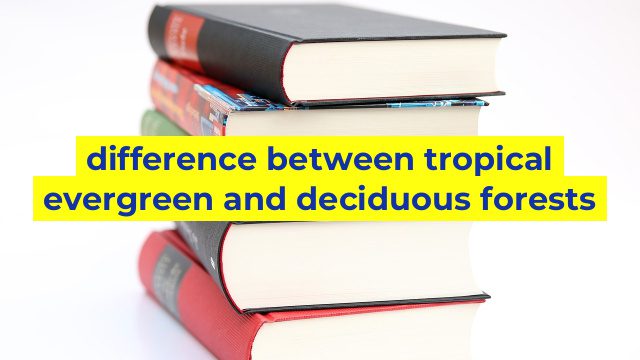The Difference Between Tropical Evergreen and Deciduous Forests
Forests are essential components of the environment and play a crucial role in the balance of nature. They provide us with essential resources such as timber, food, and oxygen, among others. Forests are found in different parts of the world, and they can be classified based on various factors such as climate, vegetation, and topography. Two common types of forests that are found in many regions of the world are tropical evergreen and deciduous forests.
Tropical Evergreen Forests
Tropical evergreen forests, also referred to as rainforests, are impressive ecosystems that rank among the most diverse habitats globally. They are characterized by dense vegetation that is green all year round, even in the dry season. These forests typically occur in areas that receive abundant rainfall and have a warm and humid climate. Some of the notable features of tropical evergreen forests include:
– High biodiversity: Tropical evergreen forests consist of a diverse range of plants, animals, and microorganisms.
– High productivity: These forests are characterized by high productivity due to the warm climate and abundant rainfall.
– Complex food webs: Tropical evergreen forests have complex food webs, with multiple species intertwined in complex relationships.
– High deforestation rates: Unfortunately, tropical evergreen forests are under threat from deforestation, logging, and land-use changes.
Deciduous Forests
Deciduous forests are forests characterized by trees that shed their leaves seasonally. These forests are found in regions that have a moderate climate with distinct seasons. They occur in areas that experience rainfall ranging from 750mm to 1500mm per annum. Some of the notable features of deciduous forests include:
– High biodiversity: Deciduous forests are characterized by a diverse range of plants, animals, and microorganisms.
– Moderate productivity: These forests have moderate productivity in comparison to rainforests.
– Distinct seasonal changes: Deciduous forests are known for their seasonal changes, with the trees shedding their leaves in the fall and growing new ones in the spring.
– Sensitive to environmental changes: Deciduous forests are sensitive to environmental changes such as climate change, pollution, and land-use changes.
The Differences between the two Forests
While both tropical evergreen and deciduous forests are essential habitats, they have several differences. Some of the primary differences include:
– Vegetation: Tropical rainforests are characterized by evergreen vegetation, while deciduous forests have trees that shed their leaves seasonally.
– Climate: Tropical rainforests have a warm and humid climate, while deciduous forests have a moderate climate with distinct seasons.
– Biodiversity: Tropical rainforests have higher biodiversity than deciduous forests due to their warm climate and dense vegetation.
– Productivity: Tropical rainforests have higher productivity than deciduous forests due to their warm climate and abundant rainfall.
In conclusion, both tropical evergreen and deciduous forests are vital components of the environment. However, they differ in vegetation, climate, biodiversity, and productivity. Understanding these differences can help us appreciate the value of both forests and take the appropriate measures to protect them.
Table difference between tropical evergreen and deciduous forests
| Features | Tropical Evergreen Forests | Deciduous Forests |
|---|---|---|
| Geographical Distribution | Found in regions with high temperature and precipitation such as the Amazon Basin, Congo Basin, and Southeast Asia | Found in regions with moderate temperatures and rainfall such as North America, Europe, and East Asia |
| Plant Life | Large trees with broad leaves that are present throughout the year | Deciduous trees that shed their leaves in the dry season |
| Biodiversity | High biodiversity with a variety of plant and animal species | Lower biodiversity compared to tropical evergreen forests |
| Climate | Warm and humid throughout the year | Varies with the seasons with hot and rainy summers and cold and dry winters |
| Soil | Poor soil with low nutrient content due to rapid decomposition of organic matter | Rich soil with high nutrient content due to accumulation of fallen leaves and other organic matter |

